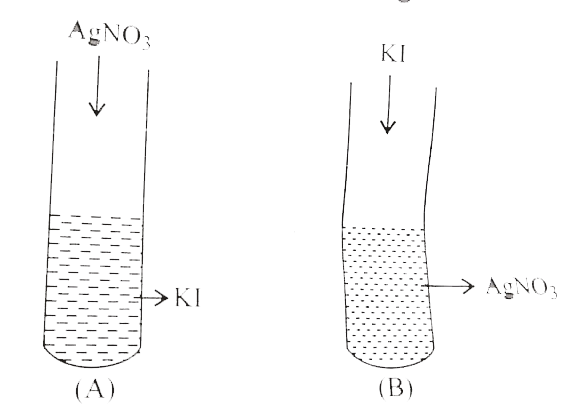A sol is prepared by addition of excess of AgNO3 solution in KI solution . The charge likely to develop on colloidal particles is :
postive
negative
no charge
both charges
The correct Answer is:a
To determine the charge likely to develop on colloidal particles when excess AgNO₃ is added to KI solution, we can follow these steps:
Step 1: Understand the Reaction
When AgNO₃ is added to KI solution, a precipitation reaction occurs. The silver ions (Ag⁺) from AgNO₃ react with the iodide ions (I⁻) from KI to form silver iodide (AgI), which is a colloidal particle.
Step 2: Identify the Colloidal Particle
The colloidal particle formed is AgI. This particle can carry a charge due to the presence of excess iodide ions in the solution.
Step 3: Determine the Charge on the Colloidal Particle
In this case, the AgI colloidal particles will selectively adsorb the I⁻ ions from the surrounding solution. This selective adsorption of I⁻ ions onto the surface of the AgI particles leads to the development of a net negative charge on the colloidal particles.
Step 4: Conclusion
Therefore, the charge likely to develop on the colloidal particles of AgI is negative.
Final Answer
The charge likely to develop on colloidal particles is negative.
---
When AgNO₃ is added to KI solution, a precipitation reaction occurs. The silver ions (Ag⁺) from AgNO₃ react with the iodide ions (I⁻) from KI to form silver iodide (AgI), which is a colloidal particle.
The colloidal particle formed is AgI. This particle can carry a charge due to the presence of excess iodide ions in the solution.
In this case, the AgI colloidal particles will selectively adsorb the I⁻ ions from the surrounding solution. This selective adsorption of I⁻ ions onto the surface of the AgI particles leads to the development of a net negative charge on the colloidal particles.
Therefore, the charge likely to develop on the colloidal particles of AgI is negative.
The charge likely to develop on colloidal particles is negative.
Similar Questions
Arsenous sulphide sol is prepared by passing H2S through arsenous oxide solution . The charge developed on the particles is due to adsorption of :
View SolutionA metal nitrate reacts with KI solution to give a block precipitate which on addition of excess of KI solution forms an orange coloured solution. The cation of metal nitrate is :
View Solution
Knowledge Check
- Question 1 - Select One
On adding AgNO3 solution to KI solution, a negatively charged colloidal sol will be formed in which of the following conditions ?
A100 mL of 0.1 M AgNO3 + 100 mL of 0.1 M KIB100 mL of 0.1 M AgNO3 + 50 mL of 0.2 M KIC100 mL of 0.2 M AgNO3 + 100 mL of 0.1 M KID100 mL of 0.1 M AgNO3 + 100 mL of 0.15 M KI
AgNO3 solution will not give white precipitate with
View SolutionThe origin of charge on colloidal solution is
View Solutioneach question contain STATEMENT-1(Assertion ) and STATEMENT - 2 (reason). examine the statement carefully and work the correct answer accoridng to the instructions given below :
STATEMENT-1: Colloidal Agl is prepared by adding Kl in slight excess to AgNO3 solution, the and particles migrate toward cathode under electric field.
STATEMENT-2: Colloidal particles adsorb ions and thus becomes electrically neutral.View SolutionA colloidal solution of Agl is prepared by two different methods as shown in the figure below:


What is the charge of Agl colloidal particles in the two test tubes (A) and (B) ?
b. Given reasons for the origin of charge.View SolutionAgNO3(solution)+NaF(solution)→ No reaction.
View SolutionA metal nitrate reacts with KI to give a black precipitate which on addition of excess of Kl is converted into orange colour solution.The cation of the metal nitrate is :
View SolutionIn the preparation of AgI sol, the excess fo AgNO3 is added to potassium iodide solution. The particles of the sol will acquire
View Solution
